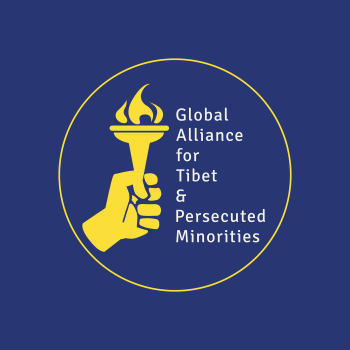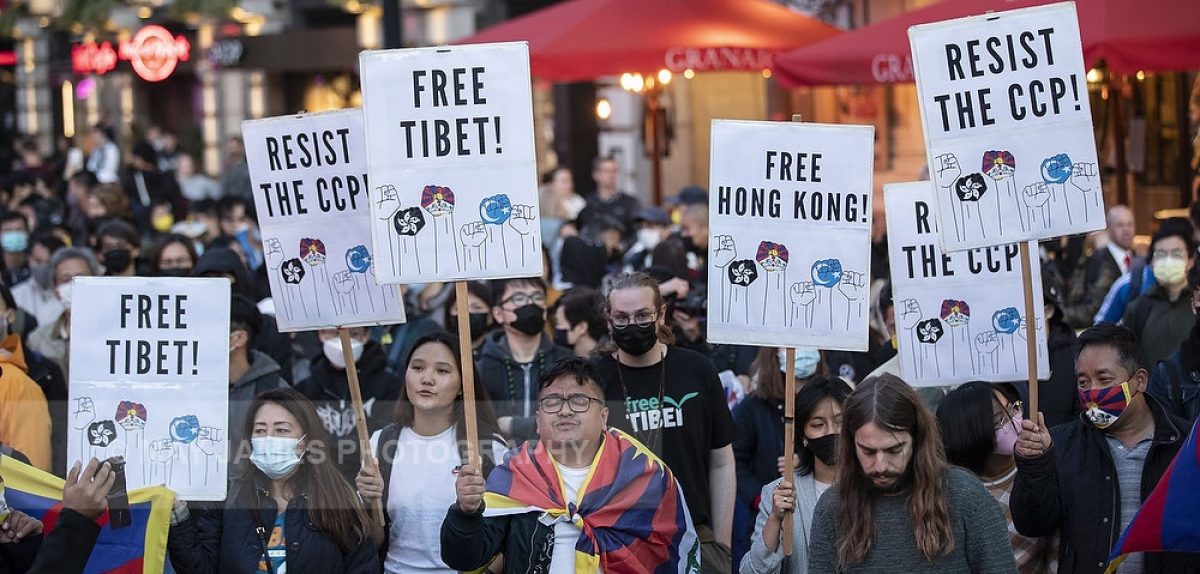March 10 – A BACKGROUND
1959 THE FIRST TIBETAN PEOPLE’S UPRISING

From the early 1950s The People’s Republic of China consolidated its 1949/’50 invasion of Tibet by constructing airfields, building roads leading to India’s border, stationing over 10,000 People’s Liberation Army troops in Lhasa, destroying monasteries, executing monks and sending thousands more to labour camps.
By 1957 Tibet’s eastern province, Kham, was in open revolt. Khampa raids on remote Chinese outposts and barracks provoked reprisals; tens of thousands of Khampas then marched towards Lhasa, doubling the capital’s population.
Enraged by the Khampa revolt and resistance, the Chinese generals in Lhasa – led by General Tan Guansan – put increasing pressure on the youthful Fourteenth Dalai Lama and his ministers to control their activities. In mid-February 1959 the Chinese discovered that promises of a “committee to discuss Khampa activities and report to the Chinese” was a fiction of the Tibetan Prime Minister, Surkhang, and his Cabinet. In reality, guns and ammunition were being distributed nationwide to prepare for armed revolt.
The defection of a key Chinese general on February 24 to the Tibetan resistance triggered open confrontation. “Under Communism I have no liberty,” General Chang Hwating confided to a Tibetan official. “The Communists treat all human beings like animals and I don’t believe we Chinese have any right to be in Tibet.” General Tan – a ruthless veteran of Mao’s Long March – ranted at the Cabinet that they had “one week to return the Chinese general. Otherwise …!” The week ended on March 3, 1959.
THE PEOPLE REVOLT
On March 4 the Dalai Lama was to take an oral examination for his geshe (doctorate) degree at the Jokhang – Lhasa’s main cathedral. But on March 3 a traitor scholar-monk facilitated an unscheduled meeting in the Jokhang between two PLA officers and the Dalai Lama to deliver General Tan’s invitation to a theatrical performance at the main Chinese army camp.
Within hours of this meeting, Peking Radio announced that the Dalai Lama had agreed to visit Beijing – an invitation which Tibet’s leader had carefully, in fact, been bypassing. Lhasa’s reaction was that the broadcast was a ploy to force the Dalai Lama to leave Tibet.
The mood for revolt was permeating Lhasa when, on March 7, the Dalai Lama agreed to attend the military’s theatrical performance on March 10. Violating standard protocol, on March 9 Tibetan security was ordered not to provide armed bodyguards to escort the Dalai Lama to the entertainment next day. The result? Rumours flew around Lhasa that their ruler was about to be kidnapped.
By sunset on March 9 thousands of citizens had ringed the yellow walls of the Norbulingka park and palaces – summer residence of the Dalai Lamas. In the city, a petition had been sent to New Delhi for help. As night fell over Norbulingka, patriotic songs rose from the crowd and shouts of “Tibet for Tibetans”. March 10 morning saw more than 10,000 Tibetans forming a human barricade against the Dalai Lama leaving his palace walls – thereby defying their leader’s own decision.
Seeing an imminent clash between the Tibetan people and Chinese army stationed in Lhasa, His Holiness the Dalai Lama left Lhasa on the night of March 17, quietly, without the knowledge of general public. He left for South Tibet to de-escalate the situation in Lhasa.
CITIZEN RULE
To lower the crowd’s anger, Surkhang invited them to choose representatives to talk to, and work with, those inside the Norbulingka. This gave birth to the Freedom Committee – a body of around 60 workers, peasants, traders and businessmen who then worked with the Cabinet during the crisis. Soon the patriotic crowd was issuing orders to security personnel and ministers via the Freedom Committee. Vehicles and pedestrians leaving or entering Norbulingka were stopped and searched by those vigilante citizens.
By late on March 10 Surkhang informed the Dalai Lama that his Cabinet had decided that he must “be prepared, if necessary, to set up his government outside Lhasa until help could come from India or the Western countries”. The escape plans began to formalize and by March 17, they were enacted. Disguised as one of his own bodyguard, bearing a rifle, the Dalai Lama marched away from his summer palace to a life of refuge in India.
THE WOMEN’S ASSOCIATION ROLE
The day of the Dalai Lama’s escape, as Tibetans prepared for certain bloodshed in Lhasa, 500 members of the Tibetan Women’s Association took out a major street demonstration. “… a solid phalanx of women came into view”, recalls a witness, “marching along the Yuthok Road … singing, carrying banners reading ‘Tibet for Tibetans’…”
The Association had been formed in the 1950s as a welfare organization, but its loyalties and activities were increasingly mistrusted by the Chinese occupation administration. In late February, General Tan had burst into a Women’s Association meeting, haranguing members and shouting: “Where there’s rotten meat the flies will gather. Get rid of the meat and the flies will case you no more trouble” – alluding to the Khampa guerrilla fighters as flies and the Dalai Lama as rotten meat.
THE LHASA UPRISING
March 20 – Bloody Friday At 2a.m. Lhasa was woken by artillery shells firing on the Norbulingka. By dawn battle began. The PLA had ringed the city with tanks and all exits were blocked. Street and alleys were barricaded and machine guns aimed down from rooftops and upper windows.
Meanwhile the 8,000-strong Tibetan Army was mainly deployed at strategic points around the city – 4,000 soldiers, alone, positioned to cover the Dalai Lama’s escape southwards. The defence inside the capital was mainly in the hands of civilians, “…ordinary simple people who had only asked to be left alone, who had hardly ever raised a finger in anger, had now been pushed so far that reason no longer counted,” writes war correspondent Noel Barber in From the Land of Lost Content*. “Lhasa had now reached that moment of the spirit when even victory was unimportant, when death and defeat were preferable to inaction.”
Women hauled sandbags and bales of wet wool to build barricades around the Jokhang so ammunition and arms could be supplied from the cathedral’s arsenal. Khampas, swords flashing, stormed Chinese positions to be mown down by machine gun fire. Chinese mortars thudded into the streets.
In the pitched battles of March 20, the Tibetans were dominant and inflicted heavy casualties on Chinese troops – on an estimated ratio of five Chinese for every dead Tibetan. But the day’s toll of dead civilian citizens is between 2-3,000 – including 20 women trapped in the Women’s Association building who were machine-gunned when they refused to surrender to a Chinese patrol. Writes the London Daily Mail’s Noel Barber: “The people of Lhasa, knowing only that their god was being hunted like an animal, were seized with a fury that made them utterly indifferent to the overpowering odds against them.”
MARCH 21 – THE DAY OF SAVAGE KILLING
By Day Two, the heart of Lhasa, the Jokhang area, was a besieged fortress, with Tibetans isolated and blocked off from reinforcements. In the afternoon an hour-long mortar bombardment killed every man defending the cathedral’s makeshift barricades.
Day-long battles – both military and civilian – raged in a dozen locations while merciless hand-to-hand fighting erupted in congested streets and narrow alleys. Guerrilla warfare tactics, using grenades and shells, were employed to make assaults on Chinese strongholds – the city’s requisitioned houses and PLA army camps.
Later morning the Norbulingka came under artillery bombardment, followed by machine gun and mortar fire, leaving devastating damage within the 10-ft high granite walls. The London Daily Telegraph correspondent, George Patterson, reported that “…800 shells were poured into the Norbulingka, destroying about 300 houses belonging to leading officials.” Chinese militia then checked every corpse to see whether their prime target, the “rebel leader, the bandit chieftain” had been eliminated.
With unlimited reserves of men, and modern weapons at hand, the Chinese occupation force annihilated Tibet’s spirited resistance fighter and by day’s end the dead joined the litter of empty mortar shells and bullet cases on Lhasa’s streets. Smoke smouldered from the petrol bombs made and hurled throughout the day by the women of Lhasa. As around 10,000 Tibetans crushed into the Jokhang Square that night, rumours circulated that Chinese tanks would be deployed there next morning.
MARCH 22 – FALL OF THE HOLY CITY
The bombardment to eliminate Tibetan resistance broke out at dawn when a Chinese mortar landed in the sacred Jokhang’s inner courtyard. So the final assault began, and by early afternoon probably half of the 10-15,000 Tibetan killed in these three bloody days of conflict had lost their lives.
Having pounded strongholds of resistance fighters to rubble, PLA tanks then turned their sights on the 7th century cathedral and its populated precincts. This final battle raged for three hours until, at around 2p.m., loudspeakers started blaring out across Lhasa.
The first voice was the military supremo, General Tan, telling the citizens that if they layed down their arms all would be forgiven. The next recorded message was from Ngabo Ngawang Jigme – a Tibetan Cabinet minister-turned- collaborator – ordering the fighting to halt in the name of the government. The Dalai Lama, he informed the silenced audience, was alive but “abducted against his will” by “reactionaries”.
With this unauthorized command, Ngabo brought the First Tibetan People’s Uprising to its finale. And the surviving resistance fighters shouldered their arms and possessions and melted away to the mountains, determined to fight another day.
Compiled by Jane Perkins |
*From the Land of Lost Content: The Dalai Lama’s fight for Tibet by Noel Barber: 1969, Collins, London. (A reconstruction of events based on eye-witness accounts).
(sourced via Tenzin Tsundue)

